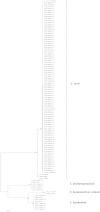Multidrug-Resistant Candida auris Misidentified as Candida haemulonii: Characterization by Matrix-Assisted Laser Desorption Ionization-Time of Flight Mass Spectrometry and DNA Sequencing and Its Antifungal Susceptibility Profile Variability by Vitek 2, CLSI Broth Microdilution, and Etest Method
- PMID: 25809970
- PMCID: PMC4432077
- DOI: 10.1128/JCM.00367-15
Multidrug-Resistant Candida auris Misidentified as Candida haemulonii: Characterization by Matrix-Assisted Laser Desorption Ionization-Time of Flight Mass Spectrometry and DNA Sequencing and Its Antifungal Susceptibility Profile Variability by Vitek 2, CLSI Broth Microdilution, and Etest Method
Abstract
Candida auris is a multidrug-resistant yeast that causes a wide spectrum of infections, especially in intensive care settings. We investigated C. auris prevalence among 102 clinical isolates previously identified as Candida haemulonii or Candida famata by the Vitek 2 system. Internal transcribed spacer region (ITS) sequencing confirmed 88.2% of the isolates as C. auris, and matrix-assisted laser desorption ionization-time of flight mass spectrometry (MALDI-TOF MS) easily separated all related species, viz., C. auris (n = 90), C. haemulonii (n = 6), C. haemulonii var. vulnera (n = 1), and Candida duobushaemulonii (n = 5). The in vitro antifungal susceptibility was determined using CLSI broth microdilution (CLSI-BMD), the Vitek 2 antifungal susceptibility test, and the Etest method. C. auris isolates revealed uniformly elevated fluconazole MICs (MIC50, 64 μg/ml), and an alarming percentage of isolates (37%) exhibited elevated caspofungin MICs by CLSI-BMD. Notably, 34% of C. auris isolates had coexisting elevated MICs (≥2 μg/ml) for both fluconazole and voriconazole, and 10% of the isolates had elevated coexisting MICs (≥2 μg/ml) to two additional azoles, i.e., posaconazole and isavuconazole. In contrast to reduced amphotericin B MICs by CLSI-BMD (MIC50, 1 μg/ml) for C. auris, elevated MICs were noted by Vitek 2 (MIC50, 8 μg/ml), which were statistically significant. Candida auris remains an unnoticed pathogen in routine microbiology laboratories, as 90% of the isolates characterized by commercial identification systems are misidentified as C. haemulonii. MALDI-TOF MS proved to be a more robust diagnostic technique for rapid identification of C. auris. Considering that misleading elevated MICs of amphotericin B by the Vitek AST-YS07 card may lead to the selection of inappropriate therapy, a cautionary approach is recommended for laboratories relying on commercial systems for identification and antifungal susceptibility testing of rare yeasts.
Copyright © 2015, American Society for Microbiology. All Rights Reserved.
Figures


References
-
- Lachance MA, Boekhout T, Scorzetti G, Fell JW, Kurtzman CP. 2011. Candida Berkhout, p 987–1278. In Kurtzman CP, Fell JW, Boekhout T (ed), The yeasts, a taxonomic study, 5th ed Elsevier Science B.V., Amsterdam, The Netherlands.
-
- Kim MN, Shin JH, Sung H, Lee K, Kim EC, Ryoo N, Lee JS, Jung SI, Park KH, Kee SJ, Kim SH, Shin MG, Suh SP, Ryang DW. 2009. Candida haemulonii and closely related species at 5 university hospitals in Korea: identification, antifungal susceptibility, and clinical features. Clin Infect Dis 48:e57–e61. doi:10.1086/597108. - DOI - PubMed
-
- Khillan V, Rathore N, Kathuria S, Chowdhary A. 2014. A rare case of breakthrough fungal pericarditis due to fluconazole-resistant Candida auris in a patient with chronic liver disease. JMM Case Rep doi:10.1099/jmmcr.0.T00018. - DOI
Publication types
MeSH terms
Substances
LinkOut - more resources
Full Text Sources
Other Literature Sources
Medical
Molecular Biology Databases

